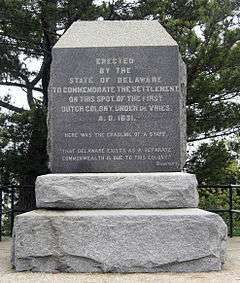David Pietersz. de Vries


| New Netherland series |
|---|
| Exploration |
| Fortifications: |
| Settlements: |
| The Patroon System |
|
| People of New Netherland |
| Flushing Remonstrance |
 |
Captain David Pieterszoon de Vries (c. 1593, La Rochelle – 13.9.1655, Hoorn[1]) was a Dutch navigator from Hoorn, Holland.
In 1617 de Vries went on a whaling voyage to Jan Mayen. In 1620 he sailed to Newfoundland, and sold the dried fish in Italy. In Toulon he joined Charles, Duke of Guise. In 1624 he went to Canada again, still in French service. After returning in the Netherlands, the Dutch West India Company put an embargo on his ship. De Vries sold his ship and left for Bayonne.
In 1627 he sailed from Hoorn to Batavia. On board was Jan Pietersz Coen only recognized during the trip. From the Dutch Indies he sailed to Masulipatnam.
In 1629, twenty-eight colonists sailed to North America and planted the Swanendael Colony in Lewes, Delaware,[2] organized for the Dutch West India Company by five merchants from New Amsterdam, who hoped to become patroons of the colony: Kiliaen de Rensselaer, Samuel Godijn, Samuel Blommaert, Albert Burgh, Joannes de Laet and De Vries. Upon visiting the colony in 1632, however, de Vries found that the settlers had been massacred, and their fort burned to the ground.[3]
He returned to North America twice, eventually establishing a settlement on Staten Island (1639),[4] and another, north of Pavonia, known as Vriessendael (1640). In 1636 de Vries built a blockhouse at Signal Hill on Staten Island.[5][6]
De Vries often acted as a go-between trying to keep the peace between the Lenape and New Netherlands director-general William Kieft. De Vries famously tried to prevent Kieft from launching the Pavonia Massacre, which set off Kieft's War. After the massacre, De Vries was influential in bringing the Hackensack Indians sachem Oratam to negotiate a truce, which did not hold in the face of Kieft's aggressive policies.[7] De Vries became a leading figure in the popular uprising against Kieft in the Dutch colony which ultimately led to the director-general's dismissal and recall for trial. Disenchanted by the New Netherlanders treatment of the indigenous population, he left his farm at Vriessendael in October 1643, and returned to Holland.[1]
In 1655 he published "Korte Historiael ende journaels aenteyckeninge van verscheyden voyagiens in de vier deelen des wereldts-ronde, als Europa, Africa, Asia, ende Amerika gedaen " (Short Historical and Journal Notes of Various Voyages in the Four Quarters of the Globe, namely, Europe, Africa, Asia, and America).[1]
On top of the Zwaanendael Museum in Lewes, Delaware, designed after the City Hall of Hoorn, stands a statue of De Vries.[8]
See also
External links
- Portrait of De Vries
- (English) http://gdz.sub.uni-goettingen.de/dms/load/img/
- (English) http://www.jstor.org/pss/1919690
- http://www.antenna.nl/wvi/nl/nest/deVries.html
References
- 1 2 3 Joris van der Meer Koopman in de West; De indianen en de Nieuw Nederlanders in het journaal van David Pietersz. De Vries, 2001 (Dutch)
- ↑ De Vries spells the name "Swanendael", and in modern Dutch it is "Zwanendaal", but in Delaware the name is conventionally written "Zwaanendael".
- ↑ "Voyages of De Vries." New York Historical Society Collection (new series), vol. III. pg. 23.
- ↑ William [Willem] Kieft (1639), "Patent Granted to Cornelis Melyn for Staten-Island, Excepting as Much of It as Had Been Granted to David Pietersen de Vries for a Bouwery", in B. Fernow, Documents Relating to the History and Settlements of the Towns along the Hudson and Mohawk Rivers (with the Exception of Albany), from 1630 to 1684., Documents Relative to the Colonial History of the State of New-York, XIII (Repr., New York: AMS Press, Inc., 1969. ed.), Albany, NY: Weed, Parsons & Co., p. 6, retrieved 26 May 2013
- ↑ Fort Wadsworth at American Forts Network
- ↑ Roberts, Robert B. (1988). Encyclopedia of Historic Forts: The Military, Pioneer, and Trading Posts of the United States. New York: Macmillan. pp. 587–589. ISBN 0-02-926880-X.
- ↑ Ruttenber,E.M.,Indian Tribes of Hudson's River, ISBN 0-910746-98-2 (Hope Farm Press, 3rd ed, 2001)
- ↑ http://history.delaware.gov/museums/zm/zm_main.shtml